BIO101 - Bora Zivkovic - Lecture 4, Part 3
In the first two parts of this lecture we tackled the
Origin of Life and Biological Diversity and the mechanisms of the
Evolution of Biological Diversity. Now, we'll take a look at what those mechanisms have produced so far - the current state of diversity on our planet.
The Three DomainsThe organisms living on Earth today are broadly divided into three large domains: Bacteria, Archaea and Eukarya (Protista, Plants, Fungi and Animals). Our understanding of the relationship between the three domains is undergoing big changes right now. The old divisions have been based on morphological and biochemical differences, but recent genetic data are forcing us to rethink and revise the way we think about the three Domains.
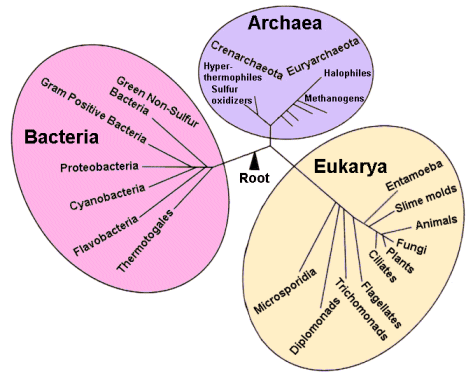
It was thought before that Bacteria arose first, that Archaea evolved from a branch off of bacterial line, while the first Eukarya (protists) evolved through the process of endosymbiosis: small bacteria and archaea finding permanent homes within the cell of larger bacteria and forming organelles. It was thought that bacteria were always simple, that Archaea are somewhet more complex, and that Eukarya are the most complex.
Neither Bacteria nor Archaea possess any organelles or subcellular compartments. The chemistry of cell walls is strikingly different between the two groups. The genes of Archaea, like Eukaryia, have introns. Until recently, it was thought that bacterial genes have no introns, however remnants of bacterial introns have been recently discovered, suggesting that Bacteria used to have introns in the past but have secondarily lost them - becoming simpler over the 3.6 billions of evolution. The enzymes involved in transcription of DNA in Archaea are much more similar to the equivalent enzymes in Eukarya than those in Bacteria.
Molecular data, as well as what we know from evolutionary theory how population size affects the strength of natural selection, a
new picture has emerged. The earliest Bacteria were simple, hugging the Left Wall of Complexity. While their population sizes were still small, Bacteria evolved greater and greater complexity, leaving the left wall somewhat, evolving more complex genomes, more complex mechanisms of DNA transcription (including introns), and perhaps even some organelles. Likewise, the Archaea split off of Bacteria (or perhaps they even appeared first) and evolved much greater complexity in parallel with the Bacteria. Eukarya also split off of Bacterial tree early on and evolved its own complexity. Thus there were three groups simultaneously evolving greater and greater complexity.
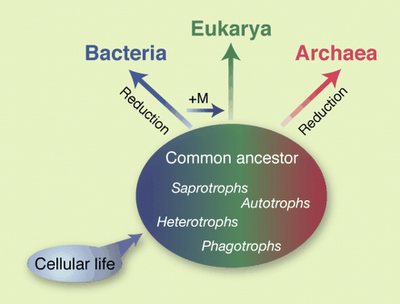
Then, Bacteria and Archaea grew up in population sizes. Instead of small pockets somewhere in the ocean, now bacteria and archaea occupied every spot on Earth in huge numbers. Large population size makes natural selection very strong. Greater complexity is not fit, thus it is selected against. Thus, the originally complex bacteria and archaea became simpler over time - they turned into lean, mean evolving machines that we see today - the dominant life forms on our planet throughout its history. They lost introns, they lost organelles, and lost many complicated enzymatic pathways, each species reducing its genome and strongly specializing for one particular niche.
On the other hand, Eukarya did not grow in numbers as much. The population sizes remained small, thus the selection against complexity was relaxed - the eukaryotes were free to evolve away from the Left Wall. They increased in complexity, engulfing other microorganisms that later became mitochondria and chloroplasts.
Thus, though we, for egocentric reasons, like to think of greater complexity as being better than being simple, the Big Story of the evolution of life on Earth is that of simplification. Natural selection harshly eliminated organisms that experimented with greater complexity - the Eukarya being the exception: an evolutionary accident that happened due to their existence in small, isolated populations in which selection against complexity is relaxed.
Bacteria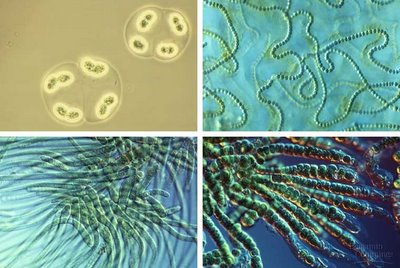
Bacteria are small, single-celled organisms with no internal structures or organelles. Bacteria may have cell walls on the surface of their cell membranes, and may have evolved cilia or flagella for locomotion. The DNA is usually organized in a single circular chromosome. Some bacteria congregate into collonies or chains, while in other species each cell lives on its own.
In the laboratory, bacteria can be easily separated into two major groups by the way their cell walls get stained by a particular stain into Gram positive (purple stain) and Gram negative (red stain) bacteria. By shape, bacteria are divided into cocci (spherical cells), bacilli (rod-like shapes) and spirilli (thread-like or worm-like cells).
Bacteria are capable of sensing their environment and responding to it - i.e., they are capable of exhibiting behavior. Bacteria are also capable of communicating with each other - for instance, they can sense how many of them are present in a particular place and they can all change their behavior once the poulation size reaches a sertain treshold - this kind of sensing is called
quorum sensing.
Many bacteria are serious pathogens of plants and animals (including humans). Others are important decomposers of dead plants and animals, thus playing important roles in the ecology of the planet. Yet others are symbionts - living in mutualistic relationships with other organisms, e.g., with plants and animals.
The inside of out digestive tract provides a home for numerous microorganisms. The best way to think about out "intestinal flora" is in terms of an ecosystem. We acquire it at the moment of birth and build it up with the bacteria we get from the environment - mostly from our parents. The bacterial populations in the intestine go through stages of building an ecosystem, similarly to the secondary succession. If, due to disease or due to use of potent antibiotics, the balance of the ecosystem is disrupted, it may recover through phases akin to primary succession.
Experiments with completely internally sterile animals (mostly pigs and rabbits) demonstrated that we rely on our intestinal bacteria for some of our normal functions, e.g., digestion of some food components, including vitamins. In many ways, after millions of years of evolution, our internal bacteria have become an essential part of who we are, and there is now a push for sequencing the complete genome of our becterial flora and to include that information in the Human Genome. The composition of the bacterial ecosystem in out guts can affect the way we respond to disease, or even if we are going to
get fat or not, thus there is much recent research on
individual variation of the intestinal flora between human individuals, so-called "poo print" (yes, scientists do have a sense of humor).
ArchaeaArchaea may have been the first life forms on the Earth. Today, they tend to occupy niches that no other organisms can. Thus, they are found living inside the rocks miles under the surface, they are found in extremely cold and extremely hot environments, in very salty, very acidic and very alkaline envrionments as well. The hot water of the Old Faithful geiser in Yellowstone national park are inhabited by a species of Archaea. They are difficult to study as they die in normal conditions in the laboratory - room temperature, neutral pH etc.
Deinococcus radiodurans is one famous Archean. It thrives inside nuclear reactors. Of course, our reactors are a very recent innovations, so the scientists were puzzled for a long time as to what natural environment selected these organisms to be able to survive in such a harsh environment. It turns out that dehydration (drying-out) has the same effects on the DNA as does radioactivity - fragmenting and tearing-up of pieces of the DNA molecule. Deinococcus evolved especially fast and accurate mechanisms for
DNA repair. Bioengineering projects are underway to genetically engineer these Archaea in such a way that they can be used to clean up radioactive spills and digest nuclear waste.
Though some Archaea have been found to live inside our bodies, not a single one has, so far, been indentified as a pathogen. Only very recently (i.e., last few weeks) has it
been shown that one archaean does have an effect on our health - not as a pathogen but as an enabler. It can migrate into roots of our teeth and set up colonies there. It then changes the environment in the tooth in such a way that it becomes conducive to the immigration and reproduction of a pathogenic bacterium than can then attack the tooth.
ProtistaProtists are an artificial group of organisms - every eukaryote that cannot be classified as a plant, a fungus or an animal is placed in this category. Thus, the number of species of protists is very large and the diversity of shapes, sizes and types of metabolism is enormous.
Some protists are microscopic unicellular organisms, like the Silver Slipper (Paramecium), while others are multicellular and quite large (e.g, sea kelp). Some protists, e.g., cellular slime molds, have a single-celled and a multi-celled phase of their life-cycle.
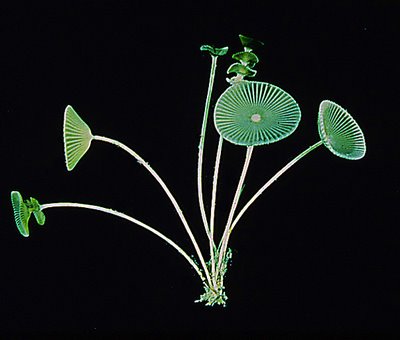
Even some of the unicellular protists can be quite large - an Acetabularia ('mermaid's wineglass', see picture) cell is about 5 cm long, thus perfectly visible to the human eye. Most protists reproduce regularly by asexual processes, e.g., fission or budding, utilizing sexual reproduction (e.g., conjugation, which is gene-swapping) only in times of stress. Some protists are surrounded only by a plasma membrane, while some others form shells of silica (glass) around themselves. Some protists have flagella or cilia, while some others move by pseudopodia (false legs - ameboid movement).
Traditionally, protists have been artificially subdivided into three basic groups according to their metabolism: protists capable of photosynthesis (autotrophs) are called Algae, heterotrophs are called Protozoa, while the absorbers are Fungus-like protists. According to morphology, protists have been divided into about 15 phyla, grouped into six major groups. New molecular techniques are thoroughly changing the taxonomy and systematics of Protista. One group, the Green Algae, has recently been moved out of Protista and into the Kingdom Plantae. Another group, the Choanoflaggelata, has been moved to the Kingdom Animalia as they are most closely related to sponges.
Some protists are parasites that cause human diseases. Most well-known of those are Plasmodium (malaria), various species of Trypanosoma (sleeping sickness, leischmaniasis and Chagas Disease) and Giardia (Hiker's Diarrhea). Dinoflagellates live on the surface of the ocean and are almost as important for absorption of CO2 and production of O2 as are forests on land.
PlantsPlants are terrestrial, multicellular organisms capable of photosynthesis (though some species have secondarily moved back into the aquatic environment or lost the ability to photosynthetize). There are about 300,000 species of plants on Earth today. They are divided into two broad categories:
non-vascular and
vascular plants. Mosses, liverworths and some other smaller groups are non-vascular plants. All other plants are vascular, meaning that they possess systems of tubes and canals that are used to transports water and nutrients from root to stem and leaves, and from leaves back to the root. Those tubes and canals are called phloem and xylem.
Of the vascular plants, some reproduce by forming
spores, while others produce
seed.
Seedless vascular plants that produce spores are, among others, ferns and horsetails. Seeds are produced by two large groups: Gymnosperms (e.g., conifers) and Angiosperms (flowering plants).
An important evolutionary trend in plants was a gradual reduction of the haploid portion of the life-cycle (
gametophyte) and simultaneous rise to dominance of the diploid portion - the
sporophyte. In mosses, for instance, almost all of the plant is haploid, except for the diploid spores developing at the very tip of the stem. In flowering plants, e.g., trees, almost all of the plant's cells are diploid (just like in us), while the flowers contain male and female gametes (pollen and egg).
FungiFungi can be unicellular (e.g., some yeasts and molds) or multicellular (e.g, mushrooms). Molecular data show that fungi are more closely related to animals than plants. Fungi are
heterotrophs that obtain nutrients from the soil by secreting enzymes into the substrate and absorbing the digested materials. They cannot photosynthetize. Fungi are composed of
hyphae, which are thin long filaments. A mass of hyphae is called the
mycelium which can build large structures like mushrooms. Spores are the means of reproduction and are formed by sexual or asexual processes.
Fungi tend to enter into symbiotic relationships with other organisms. Some of those relationships are parasitic, as in our own fungal diseases. Other relationships are mutualistic, e.g., lychens, mycorrhizae and endophytes.
Lichens are a mutualistic association between a fungus and a photosynthesizer, usually a green algae.
Mycorrhizae form mutualistic associations between the fungi and plant roots (e.g., alfalfa).
Endophytes are plants that have fungi living inside them in intercellular spaces and may provide protection against herbivores by producing toxins.
AnimalsAnimals are multicellular heterotrophs (they do not photosynthetize). They exhibit embryonic development and mostly reproduce sexually. One of the important characteristics of animals is movement. While microorganisms (bacteria, archaea and small protists) can move, large organisms (large protists, plants and fungi) cannot - they are sessile (attached to the substrate). Animals are large organisms that are capable of active movement: swimming, crawling, walking, running, jumping or flying. While some animals are also sessile, at least one phase of their life-cycle (e.g., a larva) is capable of active movement.
Some of the major transitions in the evolution of animals are evolution of tissues, evolution of symmetry (first radial, later bilateral), evolution of pseudocoelom and coelom, the difference between Protostomes and Deuterostomes, and the evolution of segmentation.
There are about 37 phyla of animals. Animals can be divided into two sub-Kingdoms:
Parazoans and
Eumetazoans. Parazoans are choanoflagellates and sponges. They do not have tissues - their cells are randomly organized. A sponge can be pushed through a sieve and all cells get detached from each other during the process, yet they will reconnect and form an intact sponge afterwards. Sponges
move by reorganization of the whole body - cells move over each other (pulling the silicate spicules along) and can move as much as 6mm per day. All other animals are Eumetazoans - their cells are organized within proper tissues.
Parazoans also have no body symmetry. Some phyla of animals (e.g, Cnidaria) have radial symmetry - they are called
Radiata. Most phyla of animals - the
Bilateria - have bilateral symmetry: the left and the right side of the body are mirror images of each other. In bilaterally symmetrical animals, there is early embryonic determination not juts of up-down axis, but also of front-back axis. Bilateral symmetry gives the animal direction - it moves in one direction, the sensory organs and the mouth tend to be in front, while excretion and reproduction are relegated to the back of the animal.
Early during development, the cells of the spherical embryo (gastrula) organize into layers. Some animals (
Diploblasts) have only two layers: ectoderm on the outside and endoderm on the inside. Most animals (
Triploblasts) have evolved a third layer in between - the mesoderm. Ectoderm gives rise to the skin and nervous system. Endoderm gives rise to the intestine and lungs, among else. Mesoderm gives rise to muscles and many other internal organs. Usually, Radiata are Diploblasts, while Bilateria are Triploblasts.
In more primitive animals, there is no internal body cavity (e.g., flatworms). In others, a cavity forms during the development between the endoderm and mesoderm - it is called
pseudocoelom (e.g., nematodes). In most animals, a proper
coelom develops between two layers of mesoderm. Our abdominal and chest cavities are parts of our coelom.
In most phyla of animals, the early embryo divides by spiral cleavage. The blastopore - an opening into the cavity of the blastula- eventually becomes the mouth. These animals are called
Protostomes. Protostomes are further divided into two groups: in one group animals grow by adding body mass (e.g., annelids, molluscs and flatworms), while others grow by molting (e.g., nematodes and arthoropods).
In Echinodermata and Chordata, the embryo divides by radial cleavage. The blastopore becomes the anus. These animals are
Deuterostomes.
Three large phyla of animals - Annelida, Arthropoda and Chordata evolved
segmentation, using Hox genes to drive the development of each segment.
You will
HAVE to read the three relevant animal chapters in the textbook to learn more about the following phyla: sponges, cnidarians, annelids, molluscs, arthropods and chordates.
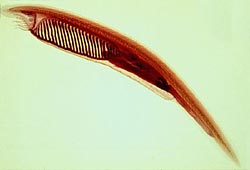
Phylum Chordata is the one we are most interested in for egocentric reasons - because we are chordates. The phylum consists of some invertebrate groups and the Vertebrata (all other animal phyla are also Invertebrata). The invertebrate chordates are hemichordates (acorn worms), tunicates (Urochordata - sea squirts) and cephalochordates (e.g., the lancelet - Amphioxus, see picture). The larvae of invertebrate chordates are very similar to the larvae of echinoderms, both groups are also Deuterostomes, and recent molecular data confirm close relationship between chordates and echinoderms as well.
All chordates have, at least at some point during the development, a notochord. The early chordates were aquatic animals. Hagfish and lampreys are two of the most primitive groups of vertebrates. Before the molecular analysis was performed, these two groups were clumped into a single group of Jawless Fish (Agnatha), but have since been split into two separate classes.
'Fish' is the lay term for several different groups of aquatic vertebrates. The most important classes are cartilagenous fish (Chondrichthyes, e.g., sharks, rays and sturgeons), lobe-finned fish (Sarcopterygii, e.g., gars) and ray-finned fish (Actinopterygii - most fish that you can think of). The latter two of those are also sometimes lumped together and called the bony fish (Teleostei). Chrossopterygii, a once-prominent group of lobe-finned fish that survives today with only one living species (
Coelacanth, or Latimeria), is the group that gave rise to ancient amphibians - the first vertebrates to invade the land (check out the
Tiktaalik website for more information).
Amphibians are frogs, toads, salamanders and cecilians. At least one portion of the life-cycle - reproduction and early development - is dependent on water. They have legs for locomotion and lungs for respiration on land.
Reptilia are a large and diverse class of vertebrates. They include lizards, snakes, tuataras, turtles, tortoises and crocodilians. They have scaly skins that allows them to survive in arid environments. They have evolved an amniotic egg - an egg that contains nutrien-rich yolk and is contained within a leathery shell. Thus, reproduction and development are not dependent on water. Many reptiles live in deserts.
A now-extinct group of ancient reptiles (therapsyds) gave rise to mammals (class
Mammalia) about 220 million years ago. The early mammals were quite large carnivores. However, during the 150 million year reign of the Dinosaurs (another extinct group of reptiles) mammals were constrained to a very small niche - that of nocturnal burrowing insectivores. Only after the demise of Dinosaurs (65 million years ago) could mammals embark on a fast evolutionary radiation that produced groups we know now.
Birds and mammals are endotherms - they can control (and keep constant) their body temperature by producing the heat in organs like muscles and liver. This is a metabolically expensive strategy that requires these animals to eat very frequently, but gives them speed and stamina and allows these animals to live in every part of the Earth, incuding polar regions. Other vertebrate classes are ectotherms - they gain their heat from the environment and, if they are cold, they are slow and sluggish.
As it is very difficult for large bodies to lose heat, large reptiles (like dinosaurs), once heated, can retain their body temperature for long periods of time - they are effectively warm-blooded. Some reptiles, notably pythons and iguanas, are capable of producing some of the heat internally. While they cannot keep a constant body temperature, they are capable of some degree of thermoregulation (e.g., becoming somewhat warmer than the external environment). By shivering their muscles, pythons raise their body temperature above ambient and use this heat to incubate their eggs.
There are about 4500 species of mammals, organized into 19 orders. The defining characteristics of mammals are milk producing glands and hair.
Monotremes (platypus and echidna) are egg-laying mammals. Their
mammary glands are not completely evolved yet - the young lick the milk of off mothers hair.
Marsupials are the pouched mammals (e.g., kangaroo, koala, opossum). The immature newborn offspring crawls up into the pouch and lives inside it until they are large enough to fend for themselves.
Placental mammals (the remaining 17 orders) have a placenta that nourishes their embryos during development. The new molecular data, coupled with a number of exciting newly-discovered fossils, are changing our understanding of genealogical relationships between different orders of mammals, including our new knowledge about the
evolution of whales, the relationship between
elephants and hyraxes, between Carnivores and Pinnipedieans (seals, etc.) and between
rodents and rabbits.
The most recent vertebrate class - the birds (
Aves) -
evolved out of a branch of Dinosaurs. There are 28 orders of bird in 166 families. Two primary characteristics distinguish birds from reptiles: feathers and flight skeleton. Their feathers are modified reptile scales. Feathers are obviously important for flight, but also insulate as birds are endotherms.
Read:Peter H. Raven, George B. Johnson, Jonathan B. Losos, and Susan R. Singer, Biology (7th edition), McGraw-Hill Co. NY, Chapters 27, 28, 29, 30, 31, 32, 33 and 34.
Additional Readings:New ideas about early evolution of life (http://scienceblogs.com/aetiology/2006/05/are_we_teaching_a_wrong_idea.php)
Previously in this series:Biology and the Scientific MethodCell StructureProtein Synthesis: Transcription and TranslationCell-Cell InteractionsCell Division and DNA ReplicationCell Differentiation and Embryonic DevelopmentGenotype and PhenotypeEvolutionBehaviorEcologyOrigin of Bioloigcal DiversityEvolution of Biological DiversityTechnorati Tag: teaching-carnival







